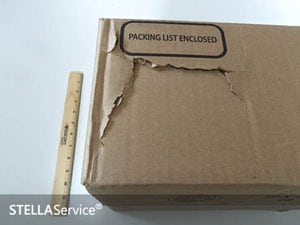 Damaged packages–like when the box carrying that new pair of boots you’re excited to receive looks like it went through the washing machine–have a lasting negative impression on consumers. According to a new study StellaService recently conducted, customers receive damaged packages in one out of every 10 shipments.
Damaged packages–like when the box carrying that new pair of boots you’re excited to receive looks like it went through the washing machine–have a lasting negative impression on consumers. According to a new study StellaService recently conducted, customers receive damaged packages in one out of every 10 shipments.
From a customer experience perspective, the last mile of online orders are notoriously difficult to control for small and large retailers alike. Regardless of whether it’s being delivered by white glove, carrier, courier or the U.S. Postal Service, the crucial moment of getting the package in the customer’s hands can reinforce a loyal relationship, or leave your shopper feeling frustrated.
In advance of the holidays, StellaService Analysts examined more than 3,200 packages received in order to understand the frequency in which shoppers are receiving damaged packages and which carriers are responsible for the highest percentages of damaged packages.
UPS delivered the highest percentage of damaged packages (11%) of the three carriers we evaluated. But it’s not all bad news — 19 companies had zero damaged packages in our study.
[Click HERE for the full list of 19 merchants with zero damaged packages]
Retailers negotiate an acceptable rate of damaged products with carriers, typically around 5%, but damaged packaging is not a common item in those contracts.
Only 36% of the retailers evaluated in our research had a damaged package rate of less than 5%. Further, of the 313 total damaged packages our researchers received, 16 products (5%) were damaged as a result. Perhaps retailers also should consider carrier service level agreements for damaged packages, in addition to damaged products.
Damaged Package Results By Carrier
UPS – 11%
USPS – 10%
FedEx – 7%
Key Learnings for Merchants
1. Know your competition and their approach to packaging.
2. Know your carriers and the terms of your service level contract. Retailers must carefully guard their brand experience by making sure carriers are meeting SLAs for damaged packages.
3. Consider negotiating a damaged package SLA with your carriers.
4. Thoroughly test your packaging. Art.com has dropped oversized boxes off its facility’s second story to determine reliabiltiy and employs 3rd party testing to ensure that packages arrive safely and in good condition.
5. Re-evaluate your packaging options at least twice a year. Amazon has more than 40 types of boxes — take a step back to evaluate your options and whether they’re relevant for your most common orders — and have a plan for those uncommon order sizes as well.
6. Use a 3rd party as a watchdog for SLAs in vendor contracts.
Jordy Leiser is co-founder and CEO of StellaService, an independent provider of ecommerce customer service performance ratings.